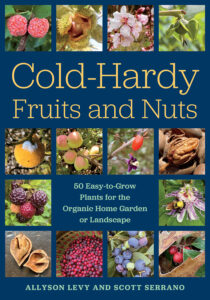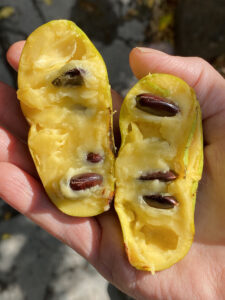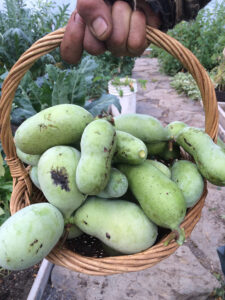Growing Nuts and Berries
Posted on Tuesday, March 29, 2022 · Leave a Comment
Every year you probably plant tomatoes. Wouldn’t it be great if they would come back every year without the bother of preparing the soil, starting seedlings in April and setting them out? Well that’s what nut and fruit trees and berry bushes do: once planted (and mature), they produce food every year. To me, there is a definite allure to plants requiring less work.

Cold Hardy Fruits and Nuts cover
I recently was sent a review copy of a wonderful book by Allyson Levy and Scott Serranno: Cold-Hardy Fruits and Nuts: 50 Easy-to-Grow Plants for the Organic Home Garden or Landscape printed by Chelsea Green Publishing (all photos supplied by the authors). When I got it I could barely pull myself away from it because it has so much to teach me.
Each of the species included has five or six pages devoted to it, and at least five excellent photos. The information starts with “Growth Difficulty Rating” – how hard is it to grow? Most are easy. It includes taste profile and uses, pollination requirements (is it self-pollinating?), site and soil conditions, zone hardiness, good cultivars to look for, and a paragraph on pests and problems, and more.
I called the authors and asked about their experience growing this diverse group of plants. They live in Stone Ridge, NY, a town about 100 miles north of NYC and 10 miles or so from the Hudson River. They are in Zone 6 where winter temperatures only go a little below zero most winters.
They are both artists, and originally started growing plants to use in their art. About 20 years ago they bought 8 acres across the street from them, and started their own arboretum, later adding another 10 acres. Their arboretum is Hortus Arboretum and Botanical Garden and is a Level II arboretum according to the Morton Arboretum.

Pawpaw cut fruit in hand
I asked them what they would recommend for fruit if someone had none, and wanted to start with winners. Scott suggested blueberries and blackberries. Both are easy and tasty. Elderberries are good, too, they said, although you need to cook the berries to make them palatable. Elderberries, honey and lemon juice make a nice syrup which I use to help prevent colds in winter.
We talked about honeyberries (Lonicera caerulea). It’s a fruit I will definitely plant this year. Although the fruit looks a little like a big oblong blueberry, it is actually in the genus with honeysuckle. It is native to northern US, Canada and Siberia. A friend gave us a few to taste last summer, and I like the flavor.
According to the book, honeyberry is the first fruit to ripen here – a couple of weeks before strawberries. But it is a couple of weeks after they turn blue and look ripe that they actually lose their astringency and turn sweet. This is the kind of information that most books or plant tags don’t have, and only comes from someone who grows and knows the plant. Allyson said she discovered that lots of berries are hidden under the leaves. The fruit gets better every year, apparently.
Another fruit in the book is pawpaw, a somewhat tropical-flavored tree fruit (banana crossed with mango flavor?). As the book explains, you need two different trees (not clones) to get pollination and fruit. I am growing it, but started out with only clones, so I not gotten fruit yet.

Hazel wild nuts in hand with leaf
Of the nuts, they recommend hazelnuts. These produce nuts as much younger plants than things like black walnut or pecans which are tall trees that require years to produce nuts. You need to have two or more hazelnuts as they are not self-fertile. Scott pointed out that the native species has smaller nuts than some of the named varieties.
Pecans are discussed in the book. The biggest difficulty is not growing the tree, but having a growing season long enough for the nuts to ripen. They need 150 to 180 days. But as the climate changes, perhaps this will not be a problem in 25 years. They note that you must have two compatible grafted varieties to get nuts, as the trees are not self-fertile. These are big, handsome trees and should be grown in full sun and rich soil if possible.
A tree that is not native, but produces a lot of food for deer is the Korean stone pine. The pine nuts we use for pesto is most often from these trees grown in Asia. The cones open up in winter and drop their seeds, which are rich in oil and high in calories. Scott said in Siberia tigers indirectly depend on the stone pine because they feed the deer and boar the tigers need to survive.

Pawpaw basket
The Hortus Arboretum and Garden is open from Mother’s Day in May until the end of October, Friday to Sunday. Admission is by donation. Because of Covid, they have been scheduling visitors on-line during the season at their website, www.Hortusgardens.org.
This book is terrifically useful to anyone interested in growing fruit and nuts. I should note that it does not cover apples, plums and peaches because those fruits are well covered by other writers, and as they say, much prone to pests and diseases. The plants discussed are generally easy to grow and trouble free. Just what we all want!
Henry is a long-time UNH Master
Gardener and author or 4
gardening books. Reach him by e-mail at
henry.homeyer@comast.net.






